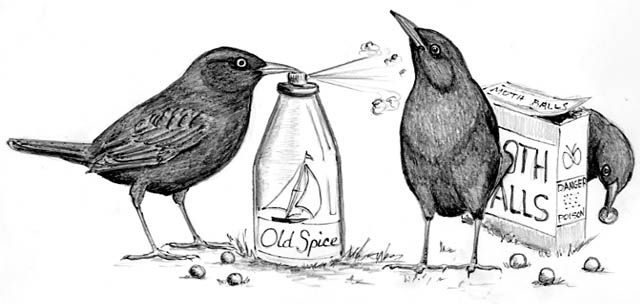
Dear Bird Folks,
Here’s a crazy story for you. The other day I put mothballs around my garden in an effort to keep the critters out. The next day I noticed that a flock of grackles had discovered the mothballs and they were picking them up and rubbing them on their feathers. The birds seemed thrilled to find the mothballs and even started fighting and stealing them from each other. Do you have any explanation for this crazy behavior?
– Mona, Eastham, MA
That sure is a crazy story Mona,
But not nearly as crazy as putting mothballs around your garden. What are you growing in your garden, wool sweaters? Or are you trying to attract my great aunt Agnes? Agnes always smelled like a walking mothball. The whole neighborhood knew when she dug out her winter clothes each fall. There wasn’t a moth within twenty miles of her house. Even my great uncle Fred would keep his distance until ol’ aunt Agnes aired out a bit.
The behavior you witnessed, Mona, is called “anting.” I know it seems like it should be called “mothballing” but anting is much easier to say. Plus, more often than not, birds rub their feathers with ants. Whether the birds use ants or mothballs, the phenomenon of anting has had scientists scratching their heads for years. Over 250 different species of birds have been observed rubbing live ants over their feathers. Why would a bird rub their body with ants? Here are a few of the theories.
Most ants will secrete or spray a lovely substance called formic acid when danger threatens. The ants use formic acid to repel would-be predators. In fact, the name formic acid comes from the latin word for ant, “formica.” (Like I have to tell you.) Underneath the handsome outer feathers of birds lies the dark world of ectoparasites. Ectoparasites are creatures like fleas and mites that live on the outside of the host. They are external. They should not be confused with internal parasites such as worms. There are also creatures that begin life as internal parasites, but soon become external parasites. They are called children.
The thought is that the birds use the acid emitting ants to rid themselves of the tiny mites that live on their bodies. Perhaps by spreading the ant acid (not to be confused with Rolaids) onto their feathers, it causes the parasites to jump ship and leave the birds alone. It is also thought that the acid helps soothe the bird’s skin from the irritation caused by the mites or from molting, thus making the rare aloe-ant very much in demand. Some birds also participate in what is known as “passive anting.” The bird will simply plop itself down in the middle of an ant hill, spread out its feathers and let the ants climb all over it. The theory is that the hungry ants will find and eat the parasites while the bird enjoys a few minutes lying in the sun.
In addition to ants and mothballs, birds have also been known to use over forty other items to rub over their feathers. The list includes beetles, millipedes, lemons, walnuts, cigarette butts, and in some fashionable cities, Old Spice.
When I first received your question, Mona, I thought that maybe I should spread out a box of mothballs in my yard to see how my grackles would react. I was just about to buy a box when the little known and seldom used part of my brain, the common sense part, spoke up and reminded me that mothballs aren’t really the best thing for birds. It turns out my brain was right, for a change. The back of the box was filled with warnings. It cautioned about touching, eating, smelling or even thinking about mothballs. Mothballs are a real pesticide and not necessarily a safe product to use indoors or out. Witnesses have seen grackles become ill after anting with mothballs.
In addition to anting, birds have several other behaviors which may also be used to rid themselves of parasites. I think we’ve all seen birds fluff out their feathers in dirt. Dust bathing is a common practice, especially in arid areas. There have even been some reports of birds taking “smoke baths.” It seems birds will occasionally stand on top of a chimney, spread their wings and let the smoke flow around their feathers. Smoke baths may not only rid the birds of parasites, but the smell of the smoke will help hide the odor of the Old Spice.
Seeing grackles using mothballs is an interesting sight for sure, Mona, but after reading the back of the package it may not be a good idea to let birds or anything else get their hands or beaks on them. Mothballs may not be as harmless as we think they are. Whoa! Now that I think of it, I haven’t seen my great aunt Agnes in years. Uh-oh.